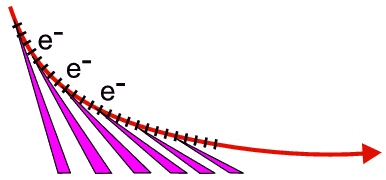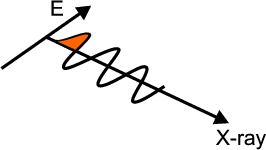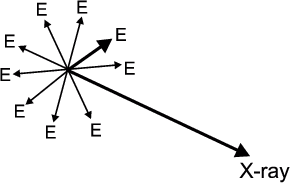 |
Properties of Synchrotron Radiation |
 Course Material Index
Course Material Index
 Section Index
Section Index
 Previous Page
Previous Page
 Next Page
Next Page
Properties of Synchrotron Radiation
As already explained, the electron bunches emit radiation as they are radially
accelerated by the dipole magnets. This radiation is contained within a
fan-like region (see below):
 Now this fan-like distribution of radiation (coloured mauve on the diagram) is quite different from that of the
radio-transmitter which obviously needs to transmit radio waves in all
directions. The reason for this is that with a synchrotron the electrons are
travelling very close to the speed of light (e.g. at 2 GeV their velocity
is around 0.9999 of the speed of light and the electron mass increases to 4000
times its rest mass). It is a consequence of relativity that at such
(relativistic) speeds the spatial bounds of the synchrotron radiation are
contracted to a narrow fan in the forward direction of the electron bunches,
typically 0.3 mrad (1 mrad ≈ 0.06 degrees) in the
vertical plane. However since the electron bunches are circulating horizontally
there is a continuum of such fans spread out over an arc (see below) so that
the final fan is wider horizontally (typically degrees) than vertically as
illustrated above.
Now this fan-like distribution of radiation (coloured mauve on the diagram) is quite different from that of the
radio-transmitter which obviously needs to transmit radio waves in all
directions. The reason for this is that with a synchrotron the electrons are
travelling very close to the speed of light (e.g. at 2 GeV their velocity
is around 0.9999 of the speed of light and the electron mass increases to 4000
times its rest mass). It is a consequence of relativity that at such
(relativistic) speeds the spatial bounds of the synchrotron radiation are
contracted to a narrow fan in the forward direction of the electron bunches,
typically 0.3 mrad (1 mrad ≈ 0.06 degrees) in the
vertical plane. However since the electron bunches are circulating horizontally
there is a continuum of such fans spread out over an arc (see below) so that
the final fan is wider horizontally (typically degrees) than vertically as
illustrated above.
 This then represents one of the great advantages of synchrotron radiation: that
it is condensed into a small angular fan, thus imparting much greater intensity
and collimation than can be obtained from conventional laboratory sources.
This then represents one of the great advantages of synchrotron radiation: that
it is condensed into a small angular fan, thus imparting much greater intensity
and collimation than can be obtained from conventional laboratory sources.
But what is this radiation? As already remarked it extends from the
radio-frequency to the X-ray regions of the electromagnetic spectrum although
we will be principally interested in the X-ray region. Such radiation is often
referred to as white (since it contains all wavelengths); its performance is
measured by a power spectrum which is a plot of radiation intensity
versus wavelength, λ; a typical version is shown
below:
 This characteristic shape is common to all dipole radiation. It shows a maximum
typically at about λ = 10 Å and
spreads out either side, slowly on the high wavelength side (termed soft
radiation) all the way to the radio-wave region, and rather abruptly on the
short wavelength side (termed hard radiation since it penetrates matter
more easily). The intensity appears to be measured in strange units, and this
therefore requires some explanation. All forms of electromagnetic radiation
show both wave-like and particle-like properties, and so sometimes we may
prefer to describe the radiation as a stream of particles, rather than as a
propagative wave. We refer to these particles as photons (which have discrete
amounts of energy E given by hc/λ - yet another
fundamental principle of physics). A common goal is to maximise the number of
X-ray photons of a desired wavelength hitting a sample, and so the intensity of
a synchrotron radiation beam has been traditionally expressed in units of
photons per second per 0.1% bandwidth per mrad2; this is so that
comparisons with other sources can be made, accounting for the time of
collection (per second), that the white source contains all wavelengths (per %
bandwidth), and that the radiation is spread out over a fan (per
mrad2). It is customary now also to refer to brilliance
(photons -1 0.1%
bandwidth-1 mrad-2 mm-2) whereby the
effective size of the electron bunches (per mm-2) is also taken into
consideration. Whatever the units, one should realise that we are invariably
talking in terms of numbers like 1012 photons per second and this
can represent an enormous transmission of energy; a point of some concern with
fragile specimens.
This characteristic shape is common to all dipole radiation. It shows a maximum
typically at about λ = 10 Å and
spreads out either side, slowly on the high wavelength side (termed soft
radiation) all the way to the radio-wave region, and rather abruptly on the
short wavelength side (termed hard radiation since it penetrates matter
more easily). The intensity appears to be measured in strange units, and this
therefore requires some explanation. All forms of electromagnetic radiation
show both wave-like and particle-like properties, and so sometimes we may
prefer to describe the radiation as a stream of particles, rather than as a
propagative wave. We refer to these particles as photons (which have discrete
amounts of energy E given by hc/λ - yet another
fundamental principle of physics). A common goal is to maximise the number of
X-ray photons of a desired wavelength hitting a sample, and so the intensity of
a synchrotron radiation beam has been traditionally expressed in units of
photons per second per 0.1% bandwidth per mrad2; this is so that
comparisons with other sources can be made, accounting for the time of
collection (per second), that the white source contains all wavelengths (per %
bandwidth), and that the radiation is spread out over a fan (per
mrad2). It is customary now also to refer to brilliance
(photons -1 0.1%
bandwidth-1 mrad-2 mm-2) whereby the
effective size of the electron bunches (per mm-2) is also taken into
consideration. Whatever the units, one should realise that we are invariably
talking in terms of numbers like 1012 photons per second and this
can represent an enormous transmission of energy; a point of some concern with
fragile specimens.
The radiation also has some other remarkable properties: It is horizontally
polarised in the plane of the electron orbit and circularly polarised above and
below the orbit. As the schematic below illustrates, whereas with laboratory
sources the X-ray electric vector vibrates in all directions perpendicular to
the propagation of the X-ray; with the synchrotron this vibration is
horizontally polarised. This has advantages which can be put to use in both
synchrotron diffraction and spectroscopy.
| Synchrotron |
Laboratory |
 |
 |
Finally, the X-ray beam is not actually continuous in time but fires in
extremely short bursts. This is simply a property of the electron bunches; the
X-rays are produced only as the bunches pass through the dipole magnet.
Depending on the number, size and speed of the bunches, each flash typically
lasts for 100 ps (100 × 10-12 second) and is
repeated typically every 1-300 ns (1 ns = 10-9
second). This time structure to the radiation can also be put to use in
certain specialised experiments.
We should finish this part by summarising the five main features of synchrotron
radiation:
-
It is intense. This can enable measurements to be conducted at great
speed and with superior statistics.
-
It is highly collimated (divergence in the order of mrads). This results
in less wastage of radiation in its passage through the optical components
towards the sample, and greater eventual resolution in measurement due to its
spatial precision.
-
It has a smooth continuous spectrum. This gives a choice of conducting
experiments with white radiation, or offering any single
wavelength by the use of monochromators (monochromators are discussed
later).
-
It is horizontally polarised.
-
It has a precise "flashing" time structure.
All these features except the last are regularly exploited in synchrotron powder
diffraction.
 Course Material Index
Course Material Index
 Section Index
Section Index
 Previous Page
Previous Page
 Next Page
Next Page






